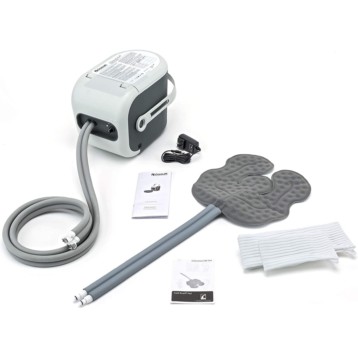|
Shrinkage of breast cancer tumors is sometimes necessary in order to execute a breast-conserving lumpectomy instead of having to amputate the entire breast/s (mastectomy). The tumor’s affects the kind of surgery that can be performed in order to remove it, the less invasive lumpectomy obviously being preferable to mastectomy. Using thermotherapy, the tumor can be drastically reduced, allowing more tumors to be removed using lumpectomy. Another advantage of the new therapeutic method is that because the tumors in patients treated with thermotherapy are smaller, medical staff can easily remove the entire tumor. By preventing the possibility that cancer cells at the edges of the incision area might remain in the body after the surgery, the combined thermotherapy and chemotherapy method ensures patients will not need to undergo additional treatment following the tumor’s removal.
|
The microwave energy is generated using two applicators located near the patient’s breast. This energy heats the cancer cells while leaving normal cells almost intact. The treatment attacks cancer cells that contain more water and ions than normal cells. The energy, applied in microwaves, makes the ions and water molecules vibrate and heat the cell. The cancer cells reach temperatures as high as 42.2 degrees Celsius (108 degrees Fahrenheit), making them inanimate. So far, the treatment has had very little side effects in clinical trials.
The treatment developed in MIT showed promising results in several clinical trials. In the latest clinical trials, 15 patients with large cancerous tumors were treated using a combination of chemotherapy and thermotherapy. On average, the tumors decreased in size by 50 percent more than tumors treated with chemotherapy alone. In another series of clinical trials, which were conducted earlier on patients with small tumors, all the cancer cells were successfully eliminated prior to surgery using the combined thermotherapy-chemotherapy method. The MIT team currently has ten systems ready to be used, and is the treatment is pending the approval of the United States FDA and the Canadian health authorities for large scale trials. Upon approval, these trials are planned to be executed in six medical centers in the United States and Canada.
TFOT recently covered several developments in cancer therapy including directed radiotherapy using carbon nanotubes developed at the University of Texas, a method for killing lone cancer cells using alpha-particles developed at the University of Washington, and a ,method for early detection of pancreatic cancer using light developed by a group of researchers from Evanston, Illinois.
More information on the new treatment can be found on the MIT news page.












